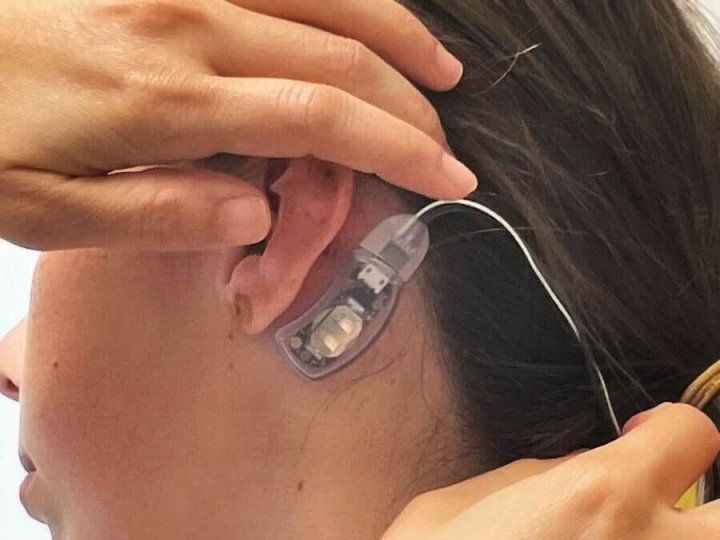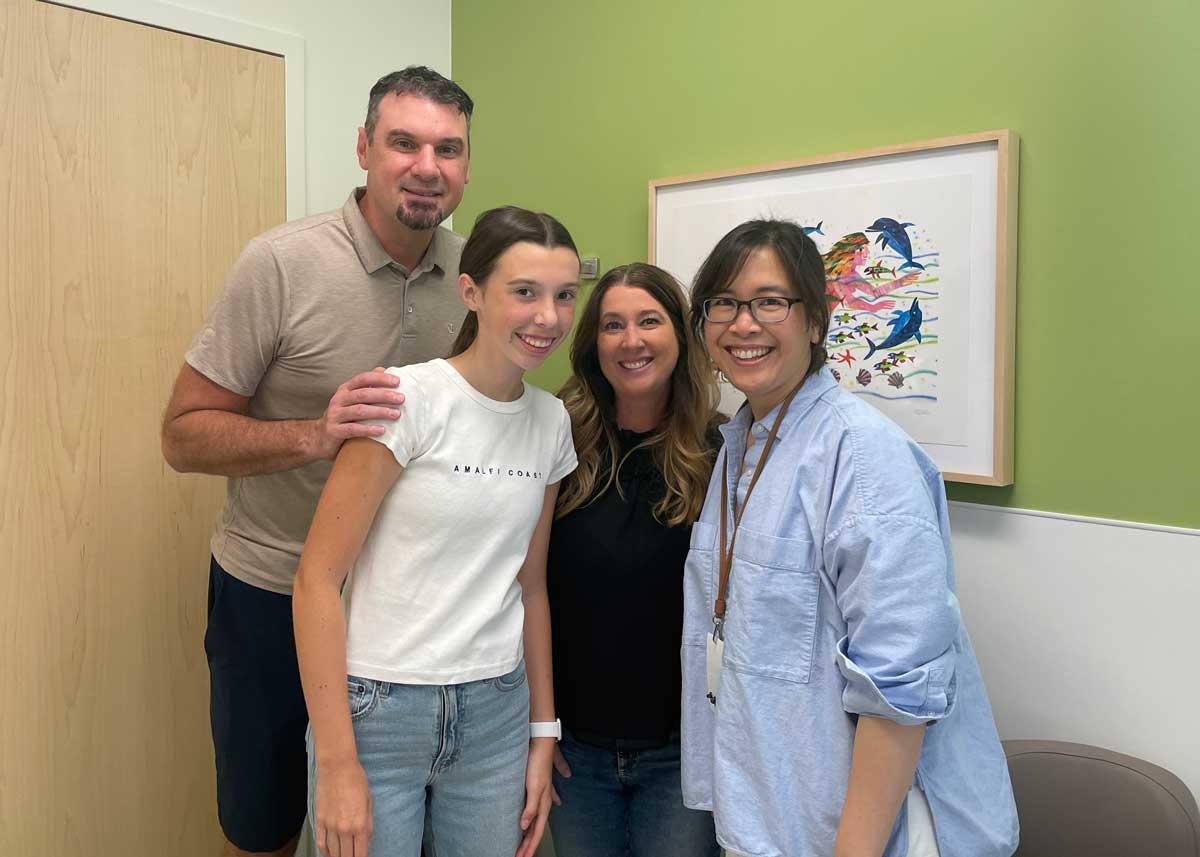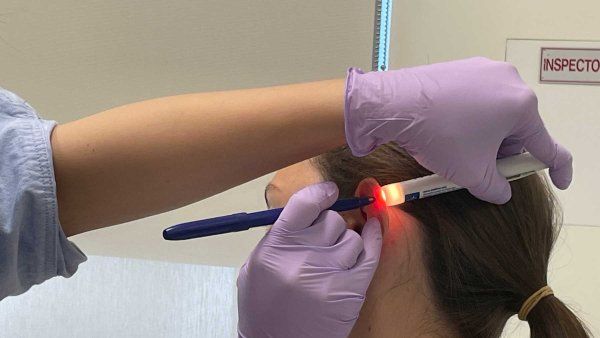Revolutionary AirPod-Sized Wearable Offers Relief for Children’s Gut Pain
Before irritable bowel syndrome (IBS) invaded her life, Taylor was a classic high-achieving teen: straight As, track, cheerleading, student government. Near the end of her freshman year, however, she began having nausea, constipation and shooting pains in her stomach. It hurt to eat, and her weight dipped dangerously low. Eventually, she had to drop her favorite activity, dance.
“My stomach hurt so bad and I was so drained,” said Taylor. “I would get in the car after school and just start crying.”
Medications offered Taylor limited relief, but she’s recently had success with IB-Stim, a small device that fits behind her ear and sends electrical impulses to her nerve bundles. The nerves activate brain areas involved in processing pain, rerouting the “pain pathways” that have caused such agony.
“It’s definitely helped more than other things I’ve tried,” said Taylor, now 17, who lives with her parents near Modesto. “Things are moving along a little better in my bowels and the pain is less.”
Acupuncture with a difference
For nearly two years, UCSF Benioff Children’s Hospital Oakland has been the only medical facility in the San Francisco Bay Area that offers IB-Stim, which is meant for kids ages 11-18 with chronic abdominal pain. By the time most kids try it, they have been through years of other treatment such as laxatives and probiotics, said Taylor’s gastroenterologist Vivien Nguyen, MD.
The beauty of IB-Stim is that it builds on the ancient principles of acupuncture and combines this with modern technology to benefit patients.”
“Typically, a patient tries IB-Stim after they have been in our pediatric gastroenterology (GI) clinic and tried various things, or they come to us from the Stad Center for Pediatric Pain, Palliative and Integrative Medicine,” said Nguyen. “Some are referred to us from outside providers across Northern California.”
IB-Stim operates in a fashion similar to acupuncture, but has some differences, said Jenifer Matthews, MD, an integrative medicine specialist who works closely with the pediatric GI clinic.
“The beauty of IB-Stim is that it builds on the ancient principles of acupuncture and combines this with modern technology to benefit patients,” Matthews said. “IB-Stim targets the nervous system through the ear like auriculotherapy, or ear acupuncture, but offers a constant stimulation over a course of four weeks.”
Effective for 80% of patients
IB-Stim is worn for five days, taken off for two days, then worn for another five. The cycle repeats for a total of four weeks. To activate the wearable, a physician first places the main device, which is about the size of an AirPod, behind the ear. She then affixes several electrodes, each of which has a tiny needle, around the ear and connects them to the device.
“There’s a little bit of pinching and discomfort at first, and then you forget it’s there,” said Taylor.

Some kids feel relief within days; for others, the response isn’t fully felt until after the last cycle of treatment, Nguyen said. Research shows IB-Stim is effective in 80% of patients.
“Some kids report being totally better with no more pain, but for the majority of kids, it’s more of a lessening of pain,” said Nguyen. “These kids have been through so much that even just a little bit of relief can be really powerful for them.”
About a quarter of kids also see a change in their bowel symptoms from the device, Nguyen added, although the device isn’t indicated for that purpose.
IB-Stim is rarely prescribed on its own; rather, it’s part of an integrative, holistic approach targeting the mind-body connection, Matthews said.
“We would never just give someone IB-Stim or medications and say, ‘Ok, good luck, see you later,’” she said. “It’s about scaffolding for a long-term individualized solution – potentially including nutrition, herbs or supplements and mind-body-spirit support.”
In Taylor’s case, this broader treatment approach included five months spent with UCSF nutrition experts in the Pediatric Eating Disorders Program, who helped her regain weight safely.
“The clinic taught me the best way to gain weight and gave me a plan,” Taylor said. “By junior year, my weight was mostly restored and we could go back to figuring out how to deal with the pain and constipation.”

Hope for earlier treatment
For most of Taylor’s junior year, she tried laxatives and pain medications that didn’t offer much relief. Her specialists now wonder if she, and others like her, might have benefited from trying IB-Stim sooner, perhaps even as a first-line treatment.
“If this is something we could offer earlier on, and if it were available to all and known as a possibility for patients, would it change the pain cycle more easily?” said Sabina Ali, MD, medical director of the Inflammatory Bowel Disease program at UCSF Benioff Children’s Hospital Oakland. “Trying so many medications creates hopelessness in these teens, and we would like to spare them that.”
One big barrier to trying IB-Stim up front is insurance, which often requires patients to try medications first, she added.
“We wish that every single patient who needs this treatment could access it right away, but insurance coverage varies,” Ali said. “Out of pocket, it’s about $4,000 for a round of treatment, which is out of reach for many families who want an alternative to medication.”
Taylor was glad for the opportunity to try something different. She’s back to her regular activities, including dance, and looking forward to college on the East Coast or in Southern California next fall.
“I think (IB-Stim) is a good thing to try. You have nothing to lose and there’s a good chance it will help,” Taylor said. “Plus, it gives you more hope; and in this situation, hope is half the battle.”

